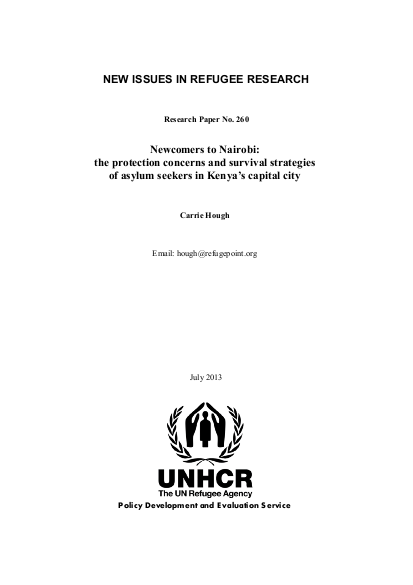
630,097, largely due to the conflict and drought affecting neighbouring Somalia.1 Somalis are not the only people seeking safety in Kenya; asylum seekers arrive from South Sudan, Eritrea, Ethiopia and the Great Lakes region on a daily basis. This presents complex logistical concerns for humanitarian agencies operating in Nairobi, where an estimated 56,000 of Kenya's registered asylum seekers and refugees are currently based.2 Little is known about what happens to these new arrivals during their first days in the Kenyan capital. Though rumours abound, almost nothing is documented with respect to this critical period. Against this background, the Government of Kenya (GoK) has begun to take responsibility for refugee status determination (RSD); it has also ended urban registration processes and recently indicated that it is contemplating reinstating its previous policy of encampment for asylum seekers and refugees. The study seeks to understand the period of potentially heightened vulnerability of asylum seekers immediately after their arrival in Nairobi. More specifically, it seeks to identify their immediate protection concerns and analyse the survival strategies they employ to counter these risks.3 The study first documents the logistics of their arrival and the protection concerns of asylum seekers within the first week of their arrival in Nairobi. These immediate protection concerns include police harassment, theft, security threats, gender-based violence, physical assault, financial difficulties and resulting economic exploitation, as well as registration-related challenges. The study also aims to understand immediate survival strategies, including accessing community-based informal support systems, as well as more formal services provided by the GoK, UNHCR and NGOs. Particular attention is paid to how new arrivals engage with the GoK’s Department for Refugee Affairs (DRA) and UNHCR registration and documentation processes. Immediate livelihood strategies are also examined as the potentially extreme vulnerabilities of new arrivals can leave them susceptible to becoming involved in high-risk activities, such as child labour, commercial sex work, street work, and isolated and potentially exploitative domestic work. A clearer understanding of the experiences of asylum seekers on arrival in Nairobi could inform the early intervention policies and programmes of the GoK, UNHCR and NGOs. By improving the targeting and effectiveness of the services provided by the Kenyan government and humanitarian organizations, newly arrived asylum seekers and refugees could benefit from enhanced protection.
Resource collections
- Accountability to affected populations (AAP)
- Somalia humanitarian response
- Topics
- UN Habitat - Urban Response Collection
- Urban Response - Urban Crisis Preparedness and Risk Reduction
- Urban Response Collection - Community Engagement and Social Cohesion
- Urban Response Collection - Economic Recovery
- Urban Response Collection - Environment and Climate Change
- Urban Response Collection - Housing, Land and Property
- Urban Response Collection - Urban Crisis Response, Recovery and Reconstruction
- Urban Response Collection - Urban Resilience
